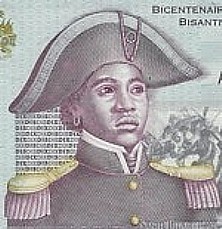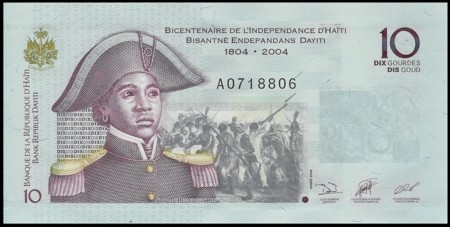HAITI
Sanite, a Revolutionary Heroine

Suzanne (Sanite) Belair was born in central Saint Domingue (now Haiti) in the commune of Verrettes, within the district, or arrondissement, of Artibonite, now known for its rice production. By the time she was ten years old, the island of Saint Domingue was embroiled in a revolution fighting off both slavery and colonialism from the French government. Unlike much of the rest of the world at that time, and even now, many women served in the revolutionary forces. Sanite (a nickname) was part of a social middle-class of emancipated slaves. Not much of her early life has been handed down, but it is known that she joined the revolutionary forces and had served as a sergeant, and later was promoted to Lieutenant. While in the military, Sanite met and married, an army officer who would later become Brigadier General Charles Belair, nephew of Toussaint Louverture, the most popular of the Haitian revolutionary commanders.
In 1801 the French had a break in their European campaigns which allowed them to embark on what was called the Saint Domingue Expedition, which was an effort to quell the unrest from the islanders. The expedition resulted in a tentative peace between the French and the rebel forces, with the leaders of the revolution being aligned with the French. In1802, during this temporary truce, Jean-Jacques Dessalines, a revolutionary leader, and contemporary of Charles Belair’s famous uncle, Toussaint Louverture, had apparently schemed both beyond the truce and beyond the revolution.
Louverture had not gathered all the rebel forces arms as he was ordered to do during the truce, and when Dessalines heard of this, he sent a letter to the French commander (and brother in law to Napoleon) Charles Leclerc. Leclerc then ordered a subordinate general, Jean Baptiste Brunet, to capture Louverture. Brunet had Louverture arrested and sent to France where he died in April 1803, after eight months in prison.
The peace between the islanders and the French was tenuous, and Dessalines had undoubtedly seen the revolution still looming amongst the population. Dessalines had also regarded Louverture as a rival, and this treachery was his way of removing Louverture as any future obstacle. This scheme may have extended to both Charles Belair and his wife Sanite, as they were also captured by the French forces. They were not sent to France, however; both Charles and Sanite were sentenced to death.
Charles was placed in front of a firing squad, with Sanite reportedly forced to watch the execution. Sanite had, by some reports, been sentenced to death by decapitation, but she demanded to be executed by a firing squad, as was her husband. Her request granted, she refused an offer to be blindfolded.
Along with many other atrocities inflicted by the French government and military on Saint Domingue, such popular leaders as Sanite, Charles and Louverture having been arrested and sent to their deaths did not sit well with the population, and the tentative peace was broken. In 1803, the rebel commanders joined up and restarted the revolution. Towards the end of the year, the French forces had succumbed to casualties from fighting and disease that were estimated at 52,000. This loss, along with the European campaign reigniting, caused the French to recall the Saint Domingue Expedition, and effectively giving up on the island.
Saint Domingue was now free, and with a new name. An independent Haiti was declared in 1804 with Dessalines leading the new country. Dessalines turned out to be a despot who killed all white Haitians and French, regardless of age and gender, estimated to be around 4,000 people. His reign was cut short when he was assassinated in October 1806, and Dessalines was afterwards disparaged by generations of Haitians. Despite this, his legacy as a great revolutionary leader eventually resurfaced, and today he is regarded as the father of the country. Sanite has endured the centuries as a heroine, strong and brave to the end, like so many of her fellow revolutionaries, male and female. She has been honored by being placed prominently on the 10 Gourde banknote in 2004.

